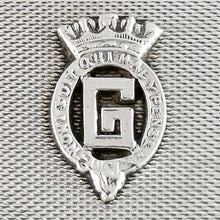Prince George, Duke of Kent Royal Presentation Cigarette Box, 1938
- Regular price
- £2,800
- Sale price
- £2,800
- Regular price
-
- Unit price
- /per
Adding product to your cart
4.5cm (1.75in) x 8.8cm (3.5in) x 13.9cm (5.5in)
Provenance:
Gifted by Prince George Duke of Kent (1902-1942) to his private secretary
Lieutenant John Arthur Lowther, MVO, RNVR (1910-1942) thence by descent.
Silver cigarette box of rectangular form, the hinged lid with engined turned decoration and centrally applied with the Duke of Kent's ‘G’ cypher encircled by the Garter motto ‘Honi Soit Qui Mal Y Pense’ (Shame on him who thinks evil of it) surmounted by a coronet of a Prince of the Blood. The interior of the lid bearing a presentation panel inscribed, ‘John from George / Canada July 28 - September 14 1941’. Maker’s mark of Walker & Hall. Hallmarked 1938.
Read more
The recipient of the present box was John Arthur Lowther, private secretary to Prince George. In 1937 Prince George acted as best man at Lowther’s wedding to Priscilla Lambert. A lieutenant in the Royal Naval Volunteer Reserve, Lowther was grandson and heir to 1st Viscount Ullswater.
Lowther was killed in the air crash that took the life of Prince George and 14 others on 25 August 1942, when the RAF S.25 Short Sunderland Mark III flying boat crashed into a hillside near Dunbeath, Caithness, in the far north of Scotland. Reportedly heading to Iceland on a morale-boosting trip to see RAF airmen, only the rear gunner, Andrew Jack, survived. The very experienced lead pilot, Flight Lieutenant Frank Goyen, was blamed for the crash. Conspiracy theorists have buzzed around this tragic mystery. They point to the fact that a normal flight plan from the starting point of Invergordon would have avoided land altogether. They also highlight that not only had Goyen’s flight plan, filed before take off, disappeared, but so too the papers of the secret court of inquiry.










